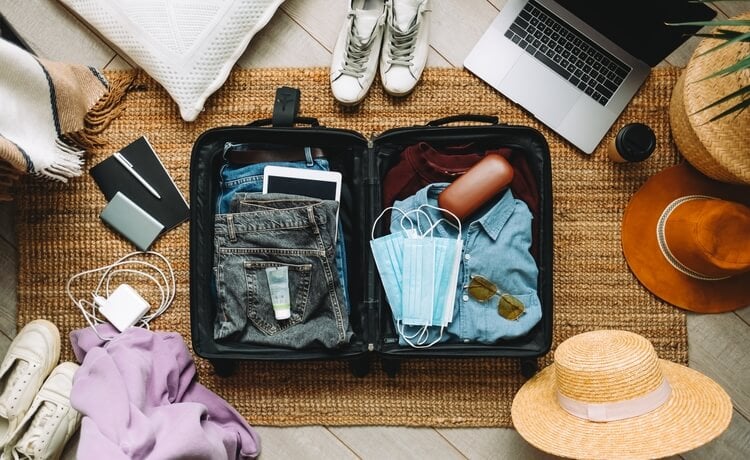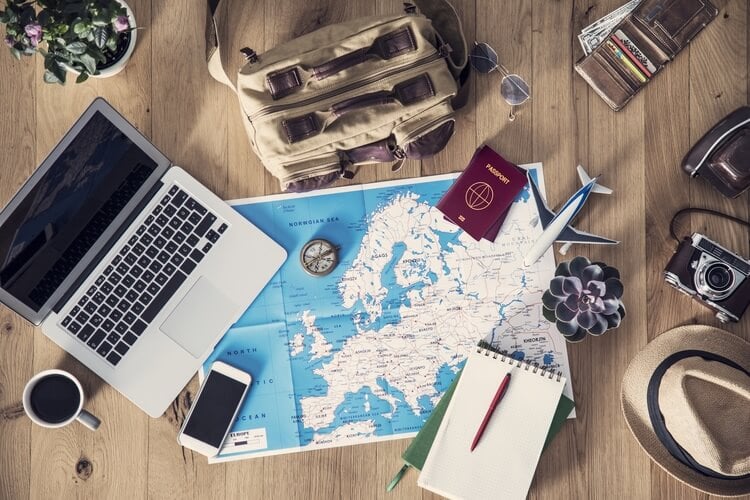Europe is an incredible continent teeming with historical landmarks, beautiful views, unforgettable cities and idyllic, Mediterranean beaches. Whether you’re dreaming of bathing under a crystal-clear sky with the waves of the Med lapping at your feet, hoping for a luxurious European villa to whisk your family away to for your big, annual holiday, or can’t stop thinking about the incredible culture and history that comes hand-in-hand with Europe’s most famous cities, it might feel a little daunting at first to think about booking a trip there. With so much to consider and so much that needs to align in order for your vacation to run smoothly and successfully, some may be put off at the thought of diving into European trip planning. But don’t worry, because with this simple and straightforward guide, you will feel sorted, organized, and ready to tackle the planning so that you can focus on what matters the most once the prep is out of the way; having a fantastic time.
How to plan a Europe Trip
The most effective way to plan a Europe trip, or any trip, is to break it down into manageable steps. Tackle the big, essential things first, and then hone in on the finer details once you have your building blocks down. If you like, make a list as you read through this article so you can keep track of what you need to book, and when, and then tick them off as you go along, so you can make sure you have covered everything.
So, let’s dive in with the first thing you need to decide when planning your European trip; where in Europe you want to go!
Where to go in Europe
How to decide where to go in Europe
Perhaps you already have somewhere in mind, or you don’t know where to start at all. Either way the first thing to do is to firm up your decision on where exactly you would like to go. Before you start, make sure you have a rough idea of what your budget is; you can fine-tune this later on, but having a rough idea means you will be able to make a reasonable guess at where you can go.
If you don’t know where to start looking, sit down and make a list of the kinds of things you are hoping for from your vacation. For example, do you want plenty of cultural and historical sights to explore in a bustling city? Do you prefer finding postcard-perfect beaches to wile away your afternoons? Or perhaps you want to stay somewhere where you can take in incredible mountain views from your vacation home, somewhere rural and peaceful?
Once you know what matters most to you when you go away, you can begin to search through European destinations based on what they can offer, and whether they match your preferences. This can be easily done by using Google and typing in what it is you are looking for, for example, “best cities in Europe”, “best beaches in Europe”, etc. Take your time browsing photographs and exploring a map to find out exactly where these places are to find out what really stands out to you.
Once you have a few shortlisted destinations, do a quick, preliminary search to find out if they offer everything you are hoping for on your vacation. For example, what cultural sights are there? What beaches are on offer? Can you get around on foot or will you need to rely on public transport? You can find this all out by using your search engine, or searching for your destination on platforms such as Instagram and Pinterest. Tripadvisor is also a fantastic source for finding out what there is to do no matter where in Europe you are looking.
Make a quick list of everything that attracts your attention, which you can then use to compare to other locations as you work out if there is enough to keep you satisfied and busy during your time away. You can also make a list of what you don’t like about your shortlisted destinations, which you can use to weigh up your decision if you cannot decide between a few destinations.
Once you have considered all of your options, discovered beautiful destinations in Europe that match what you are seeking for your vacation, and weighed up the pros and cons, the next step is to take the leap and decide for sure where you would like to go using all your research to make an informed decision you and your travel partners can feel comfortable and happy with. And, most importantly, feel excited about!
Let’s recap on this section;
- Produce a rough idea of your budget
- Decide what you want from your vacation
- Produce a list of shortlisted destinations
- Investigate each location with more depth to ensure it matches what you want from your trip
- Settle on a destination
Multi Destination Europe Trip

Europe is an incredibly popular part of the world for those who have plenty of time and are hoping to hit several destinations at once. Whether that is within the same country, for example, a trip around the famous cities in Northern Italy or a tour around the bustling, Metropolitan hubs of Spain, or whether you are hoping to hit the most famous destinations in several countries, it is easy to do in Europe with enough forward-planning.
The first thing to do is decide exactly where you want to go, of course, with a rough idea of your budget in mind. Make a list of all the destinations you have in mind, and then check them against a map of Europe to begin a rough plan of a logical route; for example, East to West or vice versa, or in a loop-like pattern. It is better to over-budget than under-budget for your first go at organizing your multi-destination vacation, as you can fine-tune and add more later if you can stretch the budget.
The next thing to decide is how exactly you are going to get around on your multi-destination trip, whether this be by car, train, coach, or even boat if you are planning a multi-destination trip exploring the Greek islands, for example. Compare the costs, e.g. petrol, train tickets, or car hire, as well as factor in things like whether it would be too tiring to drive the whole way, or whether the trains would be able to get you exactly where you need to go.
Once you know how you want to get around, you can investigate car hire companies at your destination, as well as the local public transport networks by visiting their local webpages. If you are hoping to get around by train, then Interrail is a fantastic place to look for a good overview of routes, tickets, and prices.
Once you have reorganized your destinations according to the logical route and decided how you are getting around, take a look at journey times between each destination via your chosen transport. This will allow you to work out how long you can spend at each destination, factoring the time it will take to get between each location. This will help you decide whether you have enough time to see it all, if you need to take anything out of your journey plan, or whether you even have any extra time available to find new places to explore along the way.
Let’s recap;
- Produce a rough budget
- Decide where you want to go
- Plan the most logical route between the destinations
- Decide how you would like to get around
- Produce a travel plan to ensure you have the time to reach all of your desired destinations
Finalize your budget for Europe
Now that you have a good idea of where you are going, what you are seeing, and how long you are going for, it is time to fine-tune your budget.

Make sure you have a total budget in mind as you go into your initial planning. Then, you can start to apportion your budget out the different things you will need to book. Some things you need to factor in are;
- Accommodation
- Flights
- Internal travel
- Transfers
- Airport parking
- Pet care
- Insurance
- Dining
- Excursions and tickets
- Currency
A simple way to decide the individual budget is to explore the prices of each category at your chosen destination, for example, having a quick browse of flights and accommodation to get an idea of how much it costs and what you are comfortable spending, before you assign a budget to each category. You can adjust accordingly with your overall budget in mind, as well as leave a buffer for any surprises or extras you might choose whilst on your vacation. Remember, it’s better to over-budget than to under-budget, so if in doubt, apportion generously. You can make adjustments based on what matters most to you if you find yourself going above your overall budget.
Prioritize the boring stuff
Unfortunately, before you dive into the fun part of vacation planning; your luxury accommodation, getting your flight tickets, and deciding what you’re going to do, it’s essential to get the less-fun, but extremely important essentials out of the way first.
- Check the individual entry requirements for each country you are planning on visiting, and make sure you meet the entry criteria. This includes obtaining any visas you might need. You can check this by visiting your government’s website and browsing the entry requirements listed for your chosen destination.
- Make sure you have an up-to-date passport with enough time left on it. As a general rule of thumb, you need several months left on your passport to be given entry into many European countries, though exactly how long depends from country to country, so make sure you check.
- Check your government’s advice and recommendations for your chosen destinations to find out whether you need any vaccines, recommended or required, to visit your chosen country.
- Make sure you have appropriate travel insurance. We always recommend having this sorted before you book, so that you are fully covered should your plans change, or anything happen whilst abroad.
- Ensure any pets you are responsible for are due to receive appropriate care whilst you are away.
Book your travel and accommodation
Here’s the super exciting part; you’ve done your planning, you’ve sorted out the important things, and now you’re ready to get booking.
Now that you are certain your passport is up to date and you can get a visa to visit your chosen country, next, you can book your flights. The best way to find flights is to use a flight comparison site such as Skyscanner. Here, you can directly compare all available flights on your chosen dates and from your chosen departure location, and select the ones that best suit you.
Once your flights are in the bag, next up is to decide what kind of accommodation you want.
Those heading to the bustling cities of Europe will often find that hotels offer both comfort and convenience within easy access to local public transport links. However, if you’re hoping for the utmost privacy for you and your loved ones in a vacation home that comes equipped with everything you need to have a comfortable stay in complete luxury, then a vacation villa is the way to go. If you are bringing a car, it is especially easy to reach your luxury accommodation, which are often located in serene and peaceful surroundings, so you can truly indulge yourself on your vacation.
Be sure to browse the hand-selected properties we offer at your chosen destination, as part of your booking process.
Book the other important extras
Remember when we laid out what you might need to consider when apportioning out your budget? Now that your accommodation and flights are all booked up and you have tickets on the way with your name on it, it’s time to book up the rest of the little extras. Make sure you sort out your airport parking, book a night at the airport before you go if you would like to, pay for any pet care, sort out transfers to take you to and from your accommodation at your chosen destination.
If you are booking into one of our luxury villas, you can explore all our incredible travel extras, such as help with booking transfers, private chefs, extra house-keeping, and equipment hire such as highchairs and strollers.
Plan your itinerary in Europe
It’s time to go a little more in-depth into what exactly is on offer at your chosen destination, and to organize an itinerary, whether brief or thorough, to help you structure and make the most of your time.
Places to eat

You may not want to know exactly where you are going to eat each day, but it is a good idea to get a general lay of the land, so you have a rough idea of where to go and what to expect, so you can avoid trying to make a decision when everyone is hungry and grumpy.
You can use either Google Maps or Tripadvisor to discover local restaurants, as well as what they offer, and what others have thought of them. Make a note of what catches your eye, and keep it handy if you would prefer to be a little spontaneous. Otherwise, you can book your tables in advance so you can guarantee yourself a lovely meal, whether that be for breakfast, lunch or dinner. Pre-booking is especially a good idea if you want to visit a popular restaurant, are traveling with a large group, or are planning on celebrating a special occasion.
If you have booked into one of our luxury vacation villas, many complete with fully-equipped kitchens and alfresco dining areas, find out where your nearest grocery stores are, so you can stock up and be fully prepared to cook up a storm. If you would prefer to head straight to your vacation home, get in touch with a member of our team, who can make sure all your groceries are already at your accommodation for your arrival.
Excursions, tickets and trips
Whilst it is fantastic to enjoy a little spontaneity on your vacations, and indeed, some of the best memories can come out of the unexpected, if there’s anything you would be really disappointed to miss, then it’s a great idea to get your tickets booked up in advance. Especially in the high tourist season, tickets can sell out quickly, and if you turn up on the day you may not be able to visit.
Whether it is for an unmissable European landmark, or even a day trip to a bucket list destination outside of the location you are staying, make sure you take the time to work out what you want to do, what you can fit in, and whether or not you need to book well in advance to guarantee your visit.
Either head directly to the website of the site or excursion you wish to book tickets for, explore websites such as Tripadvisor if you’re not sure what to book, or how to do so. If you’re booking with Top Villas, you can get in touch with our Guest Experience team, who will help you arrange everything you need to ensure you have a brilliant vacation ticking off everything on your list.
Internal travel
As part of your decision-making process, you should have some idea of how you want to get around at your chosen European destination, so it’s a great time to think about booking any travel you will need on the other side.
Whether that’s getting your car hire sorted, booking any transfers to and from your accommodation to the airport, getting any ferry tickets booked, or simply getting to grips with the local train schedules so you know what to do and where to get tickets on the day once you are there. Setting up your local transport means you will take out the stress of arriving in Europe without knowing how to get to where you need to go – overplanning when it comes to travel around your destination is much better than under-planning, and will ensure your vacation will run smoothly.
Get packing

So, the countdown is on, you have all of your travel documents organized, and you’ve booked up everything you want to do and see. It’s time to think about packing!
Check the rules of your airfare with regards to how much luggage you can take. It’s a great idea, if you are putting luggage in the hold, to ensure you have a sturdy case that can protect your belongings and withstand the bumps of the journey. Use a case that can lock, and be sure to leave your contact details easily accessible on your luggage on the rare off-chance it doesn’t make it to your destination at the same time as you.
If you can, also take a good backpack on the plane, where you can keep snacks and entertainment to help you through the flight. You can also use this bag on your vacation to carry everything you might need on a day-to-day basis.
When it comes to packing, check the weather forecast of your destination as you decide what clothes to take – it is always a good idea to take something you can wrap up in regardless, just in case you do experience any rain or cold spells in Europe. Sturdy shoes, sun cream, sunglasses, and all your usual toiletries and medications should all go in, as well as any outfits for any special dinners or occasions, as well as beachwear if you are planning on heading to the coast.
A fantastic idea if you are worried about forgetting any of your important daily items, is to spend some time a couple of weeks before you go keeping a note of everything you use and need over the course of several days. Once you have written them down, you can use the list to help you pack, which will also help you ensure you don’t forget anything you regularly use.
Be prepared to be flexible
As with daily life, the unexpected can still happen. Planning ahead of time is the best way to give your vacation the best chance of running smoothly and successfully whilst also making the most of your time. However, plans do change and things do come up, so be prepared to be flexible whilst on your vacation. For example, a tour may be canceled due to bad weather, or that restaurant you were really looking forward to going to might have just closed for refurbishment.
Vacations aren’t always perfect, so ensure you have back-up plans and be prepared to enjoy a different type of day from the one you were set on. Remember, sometimes the best memories come out of the unexpected, so don’t be too disheartened if some things don’t go completely to plan, and find a way to build joy out of spontaneity.
Remember, always ensure you have appropriate insurance for your vacation, if for whatever reason you need to cancel, as it is the best way to protect yourself and your finances.
Frequently asked questions about planning a trip to Europe
How many days to spend in Europe?
The continent of Europe is so large, with the sights, countries, and experiences so varied, that you could spend years there and never run out of things to do and see.
How long you spend in Europe is completely down to your personal circumstance and preferences. For example, you could enjoy a perfect taste of one of Europe’s most vibrant cities in as little as a few days, or you could completely reset in a week of basking in the peace and quiet of Europe’s countryside.
The best way to work out how many days you should spend in Europe is by working out what it is you want to do, how much time you can spare for your adventure, and then planning well-in advance and considering all of your options. It is possible to experience multiple countries in one trip, as train travel across the continent is very accessible and easy to use. So grab a map, decide where you want to go, and plan your route. Follow the steps at the very top of this article to help you plan your trip.
How to take the train in Europe?

It is very easy to catch trains in Europe, as the infrastructure is very well laid out and easy to navigate. The train lines even run across borders, so you can catch trains from one end of Europe to the other if you wanted to.
To catch trains in Europe, the best thing you can do is research thoroughly well ahead of time. Find out where the major train stations are at your chosen destinations, and then use the local web pages, which are often translated into other major languages, to help you find the tickets, routes, and fares you need to get around. You can book in advance for peace of mind, or show up on the day if you are hoping to travel spontaneously – either way it is best to have a good idea of where you need to go and what train you need to catch beforehand.
In some countries, it is also possible to buy a train pass, which will allow you to use the trains as often as you like for a set fee. The best thing to do is simply make sure you research the local transport pages thoroughly to find the right tickets for you and your plans, and to make sure you know where to go on the day you’re meant to travel by orienting yourself with a local map in advance.
How long does it take to drive through Europe?
If you were to drive non-stop from one end of Europe to the other in one go, it would take around 16 days if you didn’t stop at all. Of course, this isn’t a reasonable thing to do for a lovely vacation as you will need to stop at some point. So, if you’re planning on driving through Europe, the best thing you can do is to thoroughly research the distances between any destinations you wish to visit on a map, and planning your route well in advance to make sure you have time to visit everything you want to see.
What are the best places to travel in Europe for the first time?
If you want to go to Europe but don’t know where to start looking, then we recommend the following countries as your first port of call when it comes to exploring what there is to do and see. Combining incredible, famous cities, sights and landmarks, with some of the most awe-inspiring views in the world, these are always safe bets if you’re looking to create incredible memories on your European vacation.
We recommend France, the UK, Italy, Greece, Portugal and Spain for a first experience of Europe, so make sure you include these as you narrow down your destination list.
Tips for planning a European vacation
Let’s recap everything we have covered as we learn how to plan a trip to Europe.
- Produce a rough budget
- Work out exactly what type of vacation you want
- Produce a list of shortlisted destinations
- Investigate each location with more depth to ensure it matches what you want from your trip
- Decide your destination, or firm up your list if you are going to multiple destinations and decide how you are getting between them
- Decide how you would like to get around whilst on vacation
- Finalize your budget before you get booking
- Prioritize the important things such as visas, passports, and insurance
- Book your travel and accommodation, and any other important extras
- Plan your itinerary in as much detail as you like
- Get all packed and ready well in advance, keeping a list of what you will need to take to help you remember everything you need
- Be prepared for plans to change and to be flexible
We hope you have enjoyed reading this article and are ready to blaze ahead and get that dream vacation all booked up. If you are hoping for a slice of luxury as you experience the beauty of this vibrant continent, then be sure to check out our range of stunning villas located in incredible destinations around Europe.




